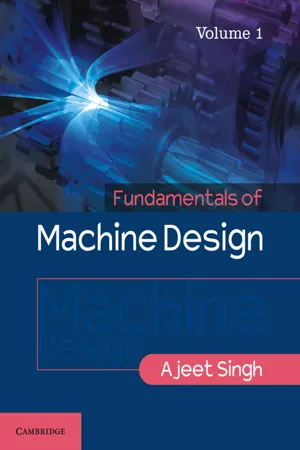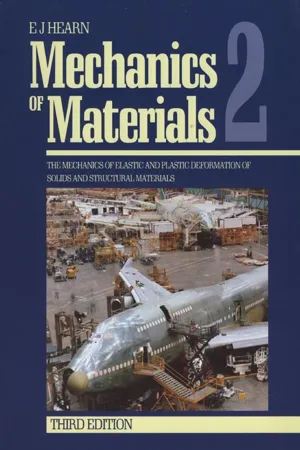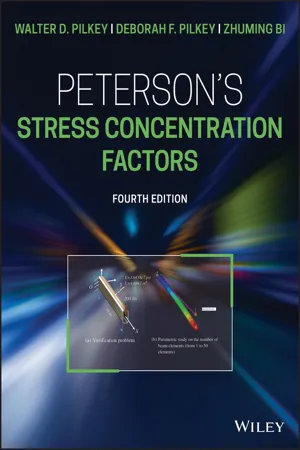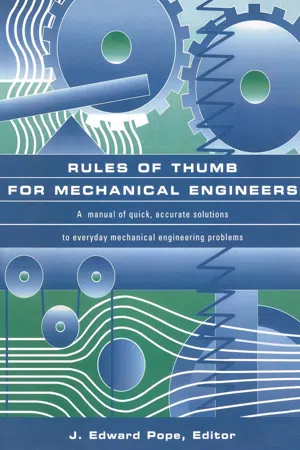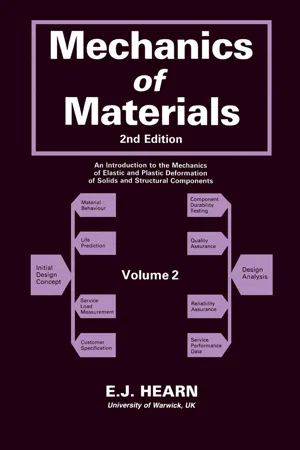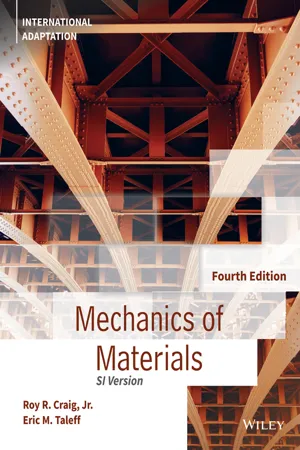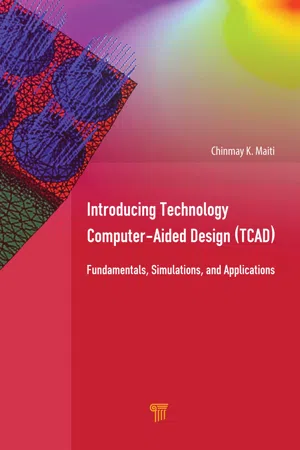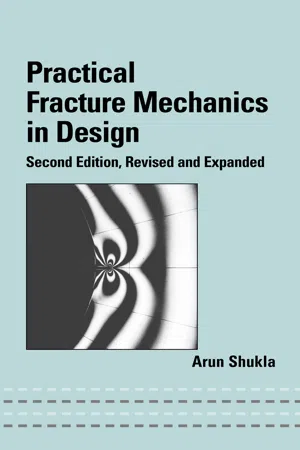Technology & Engineering
Stress Concentration
Stress concentration refers to the phenomenon where stress levels in a material are significantly higher in localized areas than in the surrounding regions. This occurs due to the presence of geometric features such as notches, holes, or sharp corners that cause stress to accumulate in those areas. Stress concentration can lead to material failure and is an important consideration in the design of structures and components.
Written by Perlego with AI-assistance
Related key terms
1 of 5
9 Key excerpts on "Stress Concentration"
- eBook - PDF
- Ajeet Singh(Author)
- 2017(Publication Date)
- Cambridge University Press(Publisher)
2. Variation in properties of material from point-to-point, which can be due to non- metallic inclusions, blow holes in castings, or cracks or flaws in the material. 3. Local bearing pressures between two mating parts, for example, mating gear teeth, ball and races of a rolling bearing, and a wheel rolling on a rail. 9.4 Stress Concentration Factor To understand the concept of Stress Concentration, see Figure 9.2(a) showing a component having abrupt change in the cross section. Since the area on the right side is lesser than the area on the left side, for the same load, the stress (Load / area) is more on the right side as shown in Figure 9.2(a). In Figure 9.2(b), it can be seen that stress is uniform where areas are constant, but it gets concentrated at a place where the area changes. Maximum stress is at the section where the area changes abruptly. Stress Concentration 257 Stress Concentration factor, K t is the ratio between maximum stress s max and nominal stress s at the same section based on the net area. Mathematically, it is expressed as: σ σ = max t K (9.1) (b) Stress Concentration (a) Nominal Stresses Figure 9.2 Stress Concentration Stress Concentration factor depends on the geometry of the part and its material. In case of static loads, it is not that serious in ductile materials as compared to brittle materials. Hence, it is important for the design of castings, etc., which are brittle. Stress Concentration becomes a matter of concern for ductile materials under conditions of varying loads or cyclic loads. 9.5 Localized Stress Concentration with an Elliptical Hole Consider a plate of width w and thickness t with an elliptical hole of major axis 2a and minor axis 2b, as shown in Figure 9.3. It is being pulled by a load P to cause nominal tensile stress s. - eBook - ePub
Mechanics of Materials 2
The Mechanics of Elastic and Plastic Deformation of Solids and Structural Materials
- E.J. Hearn(Author)
- 1997(Publication Date)
- Butterworth-Heinemann(Publisher)
Residual stresses have their greatest influence on parts which are expected to undergo high numbers of loading cycles (i.e. low strain–high cycle fatigue); they are not so effective under high strain-low cycle fatigue conditions.(5) Considerable benefit can be obtained by local strengthening procedures at, e.g. Stress Concentrations, using shot peening or other localised procedures.(6) Failures always occur at positions where the ratio of strength to stress is least favourable. This is particularly important in welding applications.(7) Consideration of the influence of residual stresses must be part of the design process for all structures and components.10.3 Stress Concentrations
Introduction
In practically all the other chapters of this text loading conditions and components have been analysed in which stresses have been assumed, or shown, to be uniform or smoothly varying. In practice, however, this rarely happens owing to the presence of grooves, fillets, threads, holes, keyways, points of concentrated loading, material flaws, etc. In each of these cases, and many others too numerous to mention, the stress at the "discontinuity" is likely to be significantly greater than the assumed or nominally calculated figure and such discontinuities are therefore termed stress raisers or Stress Concentrations .Most failures of structural members or engineering components occur at Stress Concentrations so that it is important that designers understand their significance and the magnitude of their effect since it is practically impossible to design any component without some form of stress raiser. In fatigue loading conditions, for example, virtually all failures occur at Stress Concentrations and it is therefore necessary to be able to develop a procedure which will take them into account during design strength calculations.Geometric discontinuities such as holes, sharp fillet radii, keyways, etc. are probably the most prevalent causes of failure and typical examples of failure are shown in Figs. 10.13 and 10.14 - eBook - PDF
- P. G. Forrest(Author)
- 2013(Publication Date)
- Pergamon(Publisher)
C H A P T E R V S T R E S S C O N C E N T R A T I O N S THE detrimental effect of stress raisers on fatigue strength has already been mentioned in Chapter I and the importance of avoiding or reducing Stress Concentration in parts subjected to fluctuating stress was emphasized. In this chapter the magnitude of Stress Concentration arising from geo-metrical discontinuities is discussed briefly and the effect on fatigue be-haviour is considered in some detail. In a member under axial loading the stress may only be assumed uniform over the cross section when the member is long and of constant or gradually changing cross section. Any abrupt change, such as a notch, groove or hole, causes local variation in the elastic stress distribution which is dependent both on the reduction in cross-sectional area at the discontin-uity and on the shape of the discontinuity. Similarly, for other loading con-ditions, stresses may only be assumed to be distributed in accordance with simple theory away from the point of application of load and where the members are of constant or gradually changing section. A measure of the severity of a Stress Concentration is given by the Stress Concentration factor K u which is defined as the ratio of the maximum local stress in the region of the discontinuity to the nominal local stress, evalu-ated by simple theory. The nominal stress may be based either on the net cross section through the discontinuity or on the gross cross section of the member ignoring the discontinuity. In representing the effects of Stress Concentration, the nominal stress is usually based on the net section and this procedure is adopted unless otherwise stated. It is not always possible to express this simply, however, so that it is sometimes more convenient to use the nominal stress on the gross section. - eBook - PDF
- Zhuming Bi, Walter D. Pilkey, Deborah F. Pilkey(Authors)
- 2020(Publication Date)
- Wiley(Publisher)
If an object has some geometric discontinuities, such as shoulders, grooves, holes, keyways, threads, or cracks, these discontinuities will changes simple stress distribution on well-prepared specimens in standardized material tests. Fig. 1.37 shows a few of the examples of the distribution of simple stresses. Fig. 1.38 and Fig. 1.39 show two examples that the geometric discontinuities, such as notches alter the distribution of stress in object. To make a fair comparison between the stress and strength, it is necessary to evaluate how a geometric discontinuity increases the stress at the critical area via the phenomenon of Stress Concentration. 40 FUNDAMENTALS OF STRESS ANALYSIS Area A Tc Mc I J T P A P P M M T (a) Stress distribution in tensile testing (c) Stress distribution in bending testing (b) Tress distribution in torsional testing σ σ τ σ Figure 1.37 Simple stress distribution in testing of material properties. Stress Concentration refers to the localized high-stresses occurring to a geometric discon- tinuity. Stress Concentration can be measured by the Stress Concentration factor (K). Stress Concentration factor (SCF) is defined as the ratio of the peak stress to a normal stress at a discontinuity as, K t = nom for normal stress (tension or bending) (1.36) K ts = nom for shear stress (torsion) (1.37) where the stresses and represent the maximum stresses to be expected in the member under the actual loads and the nominal stresses nom and nom are reference normal and shear stresses. The subscript t indicates that the SCF is a theoretical factor. That is to say, the peak stress in the body is based on the theory of elasticity, or it is derived from a laboratory stress analysis experiment. The subscript s of Eq. (1.37) is often ignored. In the case of the theory of elasticity, a two-dimensional stress distribution of a homogeneous elastic body under known loads is a function only of the body geometry and is not dependent - eBook - PDF
- J. Edward Pope(Author)
- 1996(Publication Date)
- Gulf Professional Publishing(Publisher)
A concentrated stress is not significant for cases involving static loading (steady stress) of a ductile material, as the material will yield in- elastically in the local region of high stress and redistrib- ute. However, a concentrated stress is important in cases where the load is repeated, as it may lead to the fatigue fail- ure of the component. Often components are subject to a combination of a steady stress ((~s) due to a constant load and an alternating stress ((~a) due to a fluctuating load such that the stresses cycle up and down without passing through zero (see Figure 10). Note that the steady stress and the mean stress ((~m) may not have the same value. The steady stress can have any value between the maximum and minimum stress values. The damaging effect of a Stress Concentration is only associated with the alternating portion of the stress cycle. Hence, it is common practice to apply only any ex- isting Stress Concentration to the alternating stress [6]. A good example of this situation is a shaft transmitting a steady state torque that is also subject to a vibratory torsional J.~ ~mean Figure 10, Fluctuating stress. 300 Rules of Thumb for Mechanical Engineers load which may be +_5% of the steady state torque. For Stress Concentration features such as shoulder fillets, the Kt would be applied to the vibratory or alternating stress. Design Hint 9 Eliminate unnecessary Stress Concentrations. Avoid abrupt changes in section where Stress Concentrations cannot be relieved by a tolerable degree of local plas- tic deformation. All fillet radii should be made as gen- erous as is practicable. 9 When possible, keep hole locations away from areas of high nominal stress. For example, in high speed rotat- ing disks such as turbine wheels (see Figure 11), holes near the bore will be in a region of high hoop stress. - eBook - PDF
Mechanics of Materials
An Introduction to the Mechanics of Elastic and Plastic Deformation of Solids and Structural Components
- E. J. Hearn(Author)
- 2013(Publication Date)
- Butterworth-Heinemann(Publisher)
In many cases a qualitative assessment of the benefits, or otherwise, of design changes is readily obtained by sketching the lines of stress flow through the component as in Fig. 25.17. Sharp changes in flow direction indicate high Stress Concentration factors, smooth changes in flow direction are the optimum solution. The following standard Stress Concentration situations are common in engineering applications and procedures for reduction of the associated Stress Concentration factors are introduced for each case. The procedures, either individually or in combination, can then often be applied to produce beneficial stress reduction in other non-standard design situations. Relief grooves §25.3 Contact Stress, Residual Stress and Stress Concentrations 823 (a) Fillet radius Probably the most common form of Stress Concentration is that arising at the junction of two parts of a component of different shape, diameter, or other dimension. In almost every shaft, spindle, or axle design, for example, the component consists of a number of different diameter sections connected by shoulders and associated fillets. If Fig. 25.40( a) is taken to be either the longitudinal section of a shaft or simply a flat plate, then the transition from one dimension to another via the right-angle junction is exceptionally bad design since the Stress Concentration associated with the sharp corner is exceedingly high. In practice, however, either naturally due to the fact that the machining tool has a finite radius, or by design, the junction is formed via a fillet radius and the wise designer employs the highest possible radius of fillet consistent with the function of the component in order to keep the s.c.f. as low as possible. Whilst, historically, circular arcs have generally been used for fillets, other types of blend geometry have been shown to produce even further reduction of s.c.f. - Roy R. Craig, Jr., Eric M. Taleff(Authors)
- 2023(Publication Date)
- Wiley(Publisher)
In Section 2.10 it was noted that these formulas do not hold in the immediate vicinity of points of application of load, but that away from that vicinity; St. Venant’s Principle ensures the validity of the above formulas for bodies of uniform cross section. The increase of stress due to localized application of a load or due to nonuniformity of the cross section is called a Stress Concentration. In the design of load-bearing members it is important to avoid Stress Concentrations whenever possible and to properly account for them when they do exist, particularly if the member is made of brittle material or is subjected to a fluctuating load (see Section 12.4). We will briefly examine the effect of Stress Concentrations in members subjected to axial loading, torsional loading, and bending. 748 Chapter 12 Special Topics Related to Design Stress Concentration—Axial Loading Figure 1.2c depicts the stress-concentration effects due to a centrally located circular hole in an axially loaded flat bar, as computed by use of the finite element method. Holes, notches, or abrupt changes in cross section produce Stress Concentrations in axially loaded members. Figure 12.1b shows the Stress Concentration due to a centrally located circular hole in a flat bar in tension. The maximum normal stress occurs at the edge of the hole on the cross section a−a, which passes through the center of the hole. In Figure 12.2 a shoulder fillet of radius r is used to smooth the transition between the wider portion of the bar and the narrower portion. The maximum normal stress for this case occurs on section b−b, where the fillet joins the narrower part of the bar. The stress distribution due to a Stress Concentration like the ones in Figs. 12.1 and 12.2 may be determined analytically through the use of the theory of elastic- ity [Ref. 12-1], or numerically by using finite element analysis [Refs. 12-2, 12-3] (see Fig. 1.2c), or experimentally through the use of photoelasticity [Ref. 12-4].- eBook - PDF
Introducing Technology Computer-Aided Design (TCAD)
Fundamentals, Simulations, and Applications
- Chinmay K. Maiti(Author)
- 2017(Publication Date)
- Jenny Stanford Publishing(Publisher)
Chapter 3 Technology Boosters Until the late twentieth century, manufacturers sought to reduce unintentional stresses because of their negative effects for devices, for example, by the creation of dislocations promoting leakage current. In recent years, new techniques to improve device performance have emerged based on the stresses induced by the manufacturing process (process-induced stress). In deeply scaled technologies, process and environment variations have become a major concern as stress is a significant source of variability in advanced VLSI technologies that impacts circuit performance. Mechanical stress affects transistor electrical parameter mobility and threshold voltage due to piezoresistivity and stress-induced band deformation, respectively. Unintentional sources of mechanical stress and intentional stress variability cause device performance to depend upon the underlying layout topology and its location in the layout. Consequently, circuit performance becomes highly placement dependent. Thus, it is imperative to capture the effects of layout-dependent stress during circuit analysis. Evaluating circuit performance involves modeling the stress distributions in the layout accurately. Introducing Technology Computer-Aided Design (TCAD): Fundamentals, Simulations, and Applications C. K. Maiti Copyright © 2017 Pan Stanford Publishing Pte. Ltd. ISBN 978-981-4745-51-2 (Hardcover), 978-1-315-36450-6 (eBook) www.panstanford.com 70 Technology Boosters 3.1 Stress Engineering 3.1.1 Unintentional Mechanical Stress The unintentional sources of stress can mainly be attributed to the thermal mismatch of the various materials used during integrated circuit (IC) manufacturing. The coef ficient of thermal expansion (CTE) of a material determines how fast a material can contract or shrink with decreasing or increasing temperature. - eBook - PDF
- Arun Shukla(Author)
- 2004(Publication Date)
- CRC Press(Publisher)
When b tends to a small value in comparison with the dimension h , the Stress Concentration factor increases markedly, as illustrated in Fig. 2.3. This suggests that a rather narrow opening perpendicular to the direction of nominal tension can produce a very high Stress Concentration, which may account for unexpected fractures even under moderate applied stresses. Under these con-ditions, however, dominated by high ( h / b ) ratios, we are entering a rather Stress and Energy Criteria 29 different approach to judging the degree of severity of a particular discontinuity. Here we no longer deal with a conventional notch geometry but with a deep and sharp crack, with the tip-of-the-crack radius having, perhaps, molecular dimen-sions. Hence the conventional definition of Stress Concentration factor cannot be applied. One should not take the results based on the Inglis formula entirely at their face value. This would only lead to a conclusion that it is impossible to design any structure to carry tensile loads because all structures and materials are scar-cely free of discontinuities and cracks. In real-life situations bridges, machinery members, ships, and airplanes may well be infested with Stress Concentrations caused by holes, notches, and cracks, and yet such irregularities are seldom dangerous. Certainly, since the appearance of Inglis’s paper, [3] a wealth of infor-mation on classical Stress Concentration methodology has developed, [5 – 7] so that almost any geometrical transition can be handled by calculation to enhance pro-duct safety. However, we should be careful with designing around a particular geometrical weakness by adding extra material, such as gussets or webs, so that “strengthening” does not produce some other form of weakness. It may not be easy to assure a proper design balance, because only nature is really good in mitigating undue stress effects. F IGURE 2.2 Notation for elliptical hole. 30 Chapter 2
Index pages curate the most relevant extracts from our library of academic textbooks. They’ve been created using an in-house natural language model (NLM), each adding context and meaning to key research topics.
